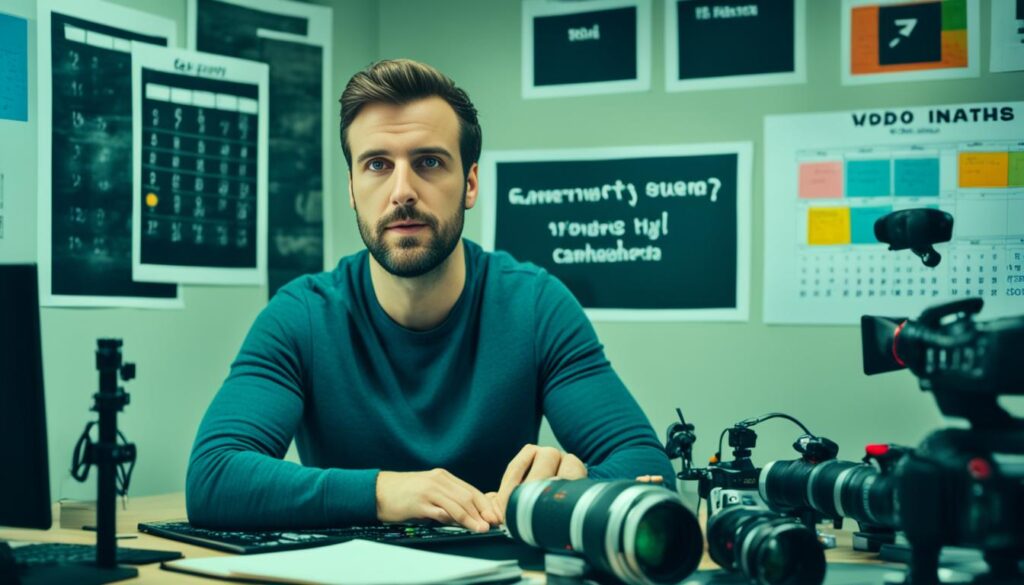Mastering the art of video shoot planning is pivotal for turning your grand visions into enthralling visual narratives. South Africa’s burgeoning film industry demands not only creativity but also substantial pre-production for filming expertise. Delving into pre-production helps carve out the intricate path of your video project, from concept development to the day of the shoot. This phase reveals the blueprint of your film or video piece, inviting you to explore location scouting intricacies, select suitable equipment, secure a cast, and orchestrate all the logistics entangled in crafting a compelling story.
Crafting the script, embracing storyboarding, and ironing out all the crucial details stand as the underpinning steps in planning a successful video shoot. It’s an organizational symphony that harmonizes storylines with technical needs, ensuring your project’s message resonates vividly with your targeted audience. Questions such as the purpose of the video, anticipated narrative, and available resources come under the spotlight, refined until a coherent and reachable goal surfaces. And if education is the key, then aligning learning objectives with expected outcomes is your staff that guides the learning curve of your audience, towards a clear and actionable horizon.
Key Takeaways
- Pre-production lays the groundwork for a video’s story arc and logistical framework.
- A clear understanding of the target audience and purpose of the video shapes the production’s direction.
- Storyboarding and scriptwriting are invaluable for visualizing and organizing the shoot.
- Technical preparation, including selecting the right equipment and scheduling, is crucial for a smooth shoot.
- Factoring the filming platform during planning affects format, style, and audience engagement.
Setting the Stage: Pre-Production Essentials
In the realm of video production, pre-production is the critical foundation upon which all successful video shoots are built. This stage covers everything from the initial conception to the intricate steps for preparing a video shoot, ensuring every piece aligns in anticipation of principal photography.
Fostering Your Vision
To kick off a project with clarity, video shoot coordination starts with fostering your vision. This involves identifying your project’s objectives and aligning them with your target audience’s preferences and demographics. Tailoring your creative choices to harmonize with your audience’s world is essential, as is setting SMART goals for a clear direction. Furthermore, crafting personas helps deep-dive into the layers of potential viewers, ensuring the narrative resonates with them on multiple levels.
Assembling Your Storyboard and Shot List
Create a visual narrative roadmap by assembling a storyboard and shot list; this is a cornerstone in filming logistics. A storyboard offers a bird’s-eye view of the project, laying out scenes visually, while the shot list details the specifics of each camera angle and movement. When these tools are employed effectively, they not just economize time and money but also smoothens the gear and crew coordination. Ensuring that each department is on the same page is vital for a seamless video shoot coordination.
Video Production Scheduling and Budgeting
An effective video production scheduling strategy encapsulates everything from hiring crew and talent to the very execution of scenes. It is crucial to book crew and talent well in advance and clarify their roles and schedules. Maintaining a clear channel of communication guarantees that everyone knows their responsibilities, has access to necessary materials, and is compensated fairly. A realistic schedule not only reflects shot durations but also incorporates buffer times to accommodate for unexpected events, thus enabling a disciplined filming process.
Here’s a glimpse into an effective scheduling model:
| Production Phase | Activity Involved | Timeframe | Notes |
|---|---|---|---|
| Pre-Production | Location Scouting | 2 Weeks | Includes travel time and weather considerations |
| Casting | Talent Auditions | 1 Week | Ensure diversity and alignment with brand identity |
| Rehearsal | Script Read-Through | 3 Days | Incorporate time for revisions |
| Shooting | Main Shoot Schedule | 4 Weeks | Factor in weekends and possible overtime |
| Post-Production | Editing | 6 Weeks | Include buffer for review and feedback loops |
Adhering to these pre-production essentials sets the stage for a video shoot that’s organized, on schedule, and poised to produce compelling content. By now, the question of “How do you plan a video shoot?” should spark thoughts of strategy, foresight, and a commitment to detail, all of which are indispensable for making any video project come to life.
How do you plan a video shoot?
Mastering the art of video shoot planning is paramount for delivering content that captivates and communicates effectively. Dive into these finely tuned video shoot planning tips and unfold the layers of video production organization required for orchestrating a successful execution of your visual narrative.
Brainstorming and Idea Development
At the genesis of planning, clean slates transform into rich tapestries of thought. Embarking on a brainstorming journey, you cradle initial sparks into robust concepts, ready for the camera’s eye. The merger of creative minds often yields unanticipated brilliance, thus fortifying the baseline of your project’s conceptual framework.
Crafting the Mood Board
- Visual references and inspirations are curated onto a mood board, encapsulating the essence of your envisioned video.
- Mood boards serve as a visual language, communicating the intended atmosphere, style, and tone to all involved.
Storyboards and Shot Lists
- Sequential artistry comes alive as storyboards illustrate the series of scenes, crystallizing the vision.
- Detailed shot lists accompany storyboards, ensuring each frame’s purpose is understood and executed with precision.
The Nuts and Bolts: Gear and Workflow
Nothing sabotages a production like unaccounted resources. Verifying equipment availability and condition well ahead of time negates potential obstacles, smoothing the path towards unwavering creativity and productivity.
Wardrobe and Props Preparation
The authenticity of your video often hinges on the minutest details. Meticulously selected wardrobe and props echo the narrative’s authenticity, knitting seamlessly into the fabric of your story.
Seamless coordination between these elements cements the groundwork for a video production that’s not just proficient, but spectacular. The pursuit of perfection in planning warrants every thread of foresight for when action is called on set.
| Planning Component | Importance | Details |
|---|---|---|
| Script | Backbone of Production | Foundation that conveys storyline, dialogue, and direction. |
| Mood Board | Aesthetic Guide | Visual mood and tone setter for the entire production team. |
| Storyboard | Visual Sequence Planner | Illustrates camera angles, scene transitions, and action sequence. |
| Shot List | Detailed Scene Breakdown | A comprehensive list of every shot needed for production. |
| Props/Wardrobe | Narrative Enhancement | Items selected to enrich the authenticity and feel of the video. |

Armed with a tactical approach to video production organization, you navigate each phase with expertise. Your commitment to planning a successful video shoot culminates in a final product that resonates with its audience and breathes life into your aspirations. Remember, in the realm of video creation, thorough planning is synonymous with limitless potential.
Conclusion
Embarking on the journey of a video shoot entails embracing the intricate steps for preparing a video shoot, where each phase is critical to the overarching success of the production. It is through a well-articulated pre-production agenda that the framework for efficiency and creative coherence is established. The craft of video shoot coordination is not just about managing a checklist; it is about sculpting an environment where innovation thrives within the boundaries of meticulous scheduling. The precision of this discipline is evident in the anticipation of possible pitfalls and the implementation of preemptive measures to safeguard the creative vision.
Commitment to a dynamic and nuanced approach to video production scheduling allows for the seamless fusion of artistic ambition with practical reality. A shoot that is well-orchestrated responds fluidly to the unpredictability of on-set dynamics while steadfastly adhering to a premeditated script and timeline. It is this adherence that transforms creative conceptions into tangible media. As each department aligns under the umbrella of a singular goal, collaboration becomes the linchpin of a triumphant shoot, ensuring every scene, every angle, and every transition is purposeful and potent.
In conclusion, the culmination of a successful video shoot is not solely gauged by the reels recorded but by the seamless synergy of preparation, adaptability, and organization. It is a testament to the art of orchestrating myriad elements into a coherent and compelling story. With detailed planning and coordination etched into the DNA of every project, filmmakers are empowered to not just envision but to actualize narratives that resonate and endure. From the storyboard to the final cut, every step is a pivotal stitch in the tapestry of cinematic storytelling.
FAQ
What are the initial steps in planning a successful video shoot?
The initial steps include defining the project’s purpose, identifying the target audience, setting clear objectives, establishing learning outcomes for educational videos, and deciding on the distribution platform. These foundational decisions inform all further steps in the pre-production and production processes.
How important is pre-production for a video shoot?
Pre-production is critical as it covers brainstorming, concept development, scriptwriting, storyboarding, casting, location scouting, and arranging the logistics of your shoot. Effective pre-production sets the foundation for a smooth and efficient production and post-production phase.
What are crucial aspects of fostering a vision in video production?
Fostering your vision involves understanding your project’s goals, knowing your audience’s characteristics, creating content that resonates with them, ensuring all creative choices align with your brand, setting SMART goals, and developing personas to better understand your audience’s perspective.
What is the purpose of assembling a storyboard and shot list?
Assembling a storyboard and shot list helps visualize the narrative, plan each shot’s composition, sequence your shots, and ensure that all team members are on the same page. This step is fundamental for organizing the shoot and can save time and resources during production.
How do video production scheduling and budgeting affect a video shoot?
Scheduling and budgeting are vital for ensuring that the shoot runs smoothly. They involve booking crew and talent, planning for the availability of equipment, and creating a realistic timeline that includes buffer times for unexpected challenges. Budgeting ensures that you have the resources needed to carry out the shoot and can pay your crew and talent appropriately.
How do you prevent equipment double bookings and manage gear availability?
To prevent equipment double bookings and manage gear availability, you must plan ahead by creating a detailed equipment list, checking availability dates, and scheduling when each piece of gear will be used. Regular communication with your crew is essential to confirm that all equipment is ready and in good working condition for the shoot.
What should be included in a comprehensive video project plan?
A comprehensive video project plan should include scripts, creative ideas, mood boards, storyboard, shot lists, gear and workflow checklists, and the preliminary organization of props and wardrobe. It should encapsulate all aspects of the visual and practical elements of the production.
How do you accommodate changes during a video shoot?
To accommodate changes during a shoot, it’s important to stay adaptable and have contingency plans. This can include having backup locations, alternative shot lists, additional budget for emergencies, and clear communication channels so that all crew members can stay informed and adjust accordingly.
What are the best practices for coordinating with talent and crew?
Best practices for coordinating with talent and crew involve early booking, providing clear role descriptions, ensuring access to necessary materials, frequent communication, and fostering a collaborative environment. It’s also crucial to respect their time and compensate them fairly and on schedule.
Why is it important to define the platform for your video during planning?
Defining the platform where the video will be distributed is important because each platform may have specific requirements regarding format, resolution, length, and engagement features like closed captions. Knowing this early in the planning process helps tailor your content to meet these requirements, thereby enhancing the effectiveness of your video.






